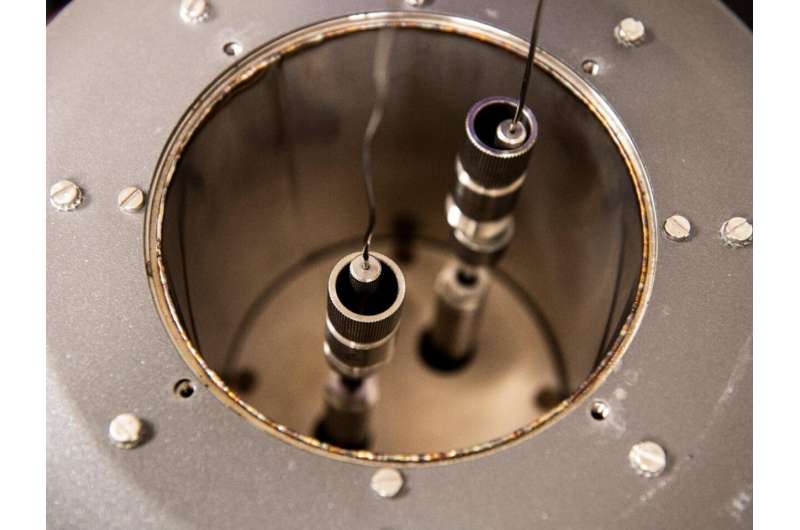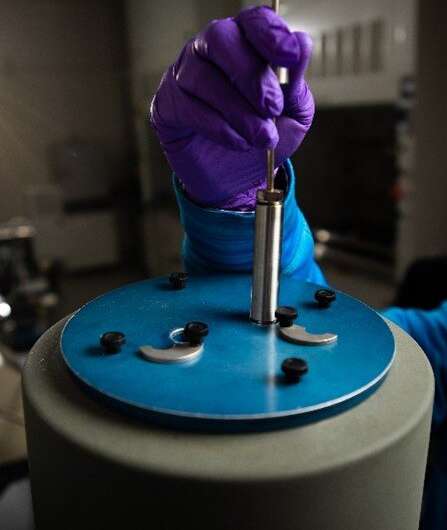This article has been reviewed according to Science X's editorial process and policies. Editors have highlighted the following attributes while ensuring the content's credibility:
fact-checked
trusted source
proofread
Burning calories for energy in the calorimetry lab

What is a calorie? While most people think of calories in relation to food, calories are simply a unit of heat energy. In fact, measuring calories is essential to energy science because every chemical reaction involves energy. Some reactions give off heat, while others require an input of heat to occur. Measuring these heat changes can let scientists understand what is happening during chemical reactions.
Researchers at Pacific Northwest National Laboratory's (PNNL's) Energy Sciences Center (ESC) are studying heat changes to understand how chemical reactions progress over time and how energy changes affect reactions. They use specialized instruments called calorimeters, located within PNNL's calorimetry lab.
"Calorimetry lets us see into the heart of reactions," said Tom Autrey, a Laboratory Fellow at PNNL. "There are not many techniques that can provide this information in a single measurement, allowing us to gain greater insight into the energy landscapes defining chemical transformations. This insight is critical to developing a rational design to control how reactions respond to changes in their environment."
These concepts of heat exchange are central to two important fields at the core of the ESC: energy conversion and energy storage.
"Changes in energy are at the heart of many important problems," said Autrey. "We need energy for all chemical conversions, including those that will help us close the carbon cycle or develop non-carbon-based fuels. The more we understand about the energies at play, the more effective our research. Calorimetry is central to our ability to study reaction energies."
The ESC lab includes a special calorimeter known as "The Flipper," which physically rotates to allow solids, liquids, and gases to effectively mix. Other instruments are suited to different combinations of solids, liquids, and gases, providing researchers with a full suite of tools.
Storing hydrogen in materials
Hydrogen is an exciting option for non-carbon fuels and the target of the Department of Energy's "Hydrogen Shot," announced in 2021. Realizing these hydrogen production goals will present an additional problem: how to manage all the hydrogen, which is extremely challenging to store and transport in its pure form.
New research led by Autrey is exploring how to effectively store hydrogen in chemical bonds with stable materials. The group previously explored storing hydrogen in molecules and is now applying their approach to 2D carbon, boron, and nitrogen (CBN) materials. The CBN materials are lightweight, durable, and have the potential for large-scale production. The team will explore how altering the surface of the CBN materials affects their ability to interact with hydrogen.

Ideally, any sort of hydrogen storage material needs to sit in a Goldilocks zone of adsorption. It should bond strongly enough with hydrogen to stay stable but loosely enough to release the hydrogen when needed. The team plans to use the calorimeters to identify the all-important energies of the storage and release reactions. The ability to study systems that are a mixture of phases—solid, liquid, and gas—is essential to their success. The capabilities of the calorimetry lab will help the team understand and tune the bonding between hydrogen and the materials.
The project is in the early stages but represents a promising direction for work in the calorimetry lab. "Research into hydrogen storage is essential to a carbon-neutral future," said Autrey. "Our new work is exciting, taking previous expertise from our group and combining it with PNNL materials science leadership. Having the entire team and capabilities under one roof in the ESC makes collaboration easier, accelerating our progress through more frequent interactions and the co-location of synthesis, spectroscopy, and calorimetry labs."
Using calorimetry to study hydrogenation
In addition to its potential as a fuel, hydrogen is central to many chemical transformations, including converting biomass into fuels or feedstocks and re-using plastics. Researchers working in the calorimetry laboratory are exploring the energies behind hydrogenation, a chemical reaction that adds hydrogen to different molecules.
"Hydrogenation is a fundamental catalytic reaction," said Chemist Abhi Karkamkar. "The better we understand all aspects of the reaction, the more effectively we can design new catalysts."
Catalysts are an essential part of chemical transformations. They can affect how fast reactions occur by changing the energy barrier that must be met to let the reaction move forward. Calorimetry allows researchers to study these energy barriers to better understand how different catalysts change the landscape of a reaction.
Postdoctoral Scientist Thuy Le is studying how solvents affect the catalytic hydrogenation of a model reaction for biomass conversion, the transformation of benzaldehyde to benzyl alcohol. Previous work from the group found that solvent played a critical role in the energies of the reaction. Le and the team applied a similar approach to a new system: ruthenium on titanium dioxide.
Preliminary results show that the solvent plays a role in affecting the interaction between the hydrogen and the catalyst. The researchers moved beyond just studying the solvent and are exploring how pH—the relative acidity of the solvent—affects the process.
"Changing the pH of a solution makes the system more complex," said Le. "Knowing the underlying energetics, which we can determine through calorimetry, becomes all the more important."
Measuring fundamental energies with calorimetry
Energy is at the heart of chemical transformations. Researchers often need to study reactions in great detail to understand how changes to the environment affect the results. A recent example led by scientists at PNNL focused on molecules involved in nuclear safety.
DABCO is a chemical used in nuclear fuel reprocessing plants and deployed to help clean up spills of radioactive iodine-based molecules. It reacts with a range of iodine-containing molecules. The PNNL-led research team used a combined approach to determine the fundamental energy characteristics of reactions between DABCO and different carbon-iodine molecules known as iodoalkanes.
To study how DABCO reacts with the different iodoalkanes, the researchers combined dissolved DABCO with an iodoalkane inside a calorimeter and measured the energy of the reaction. The team studied how DABCO reacts with two different iodoalkanes in several solvents. They found that reactions with the larger, bulkier iodoalkane are slower than the smaller iodoalkane in all solvents.
"Having access to the calorimeters was essential for finishing this work," said chemist Tom Blake, who led the study. "Our approach combined multiple experimental techniques with computational modeling. Calorimetry allowed us to obtain the data we needed to create a full picture of the reaction energies. We hope that others can use this approach to explore different reactions."
The calorimetry lab offers researchers techniques to gain a richer picture of chemical reactions, essential for a renewable energy future.

















